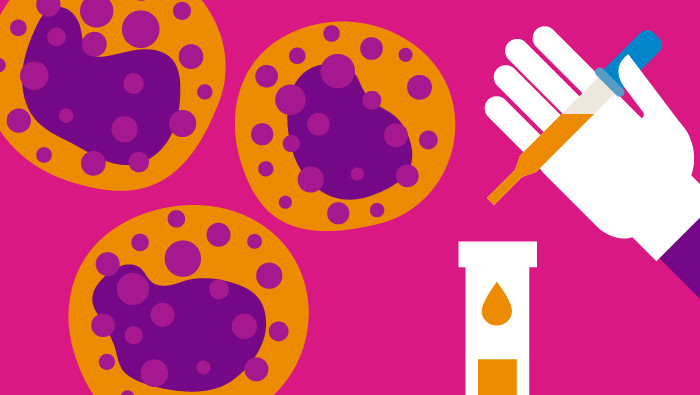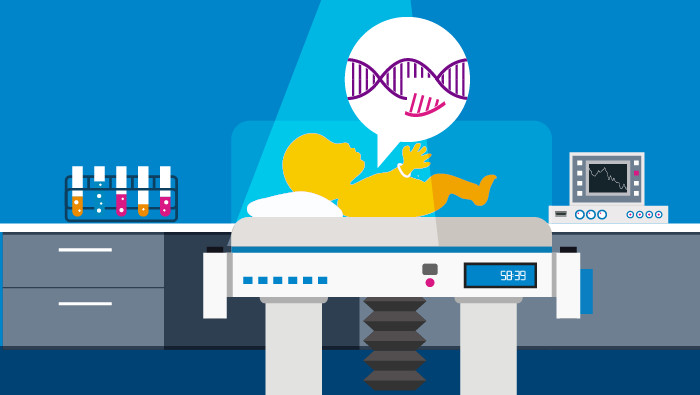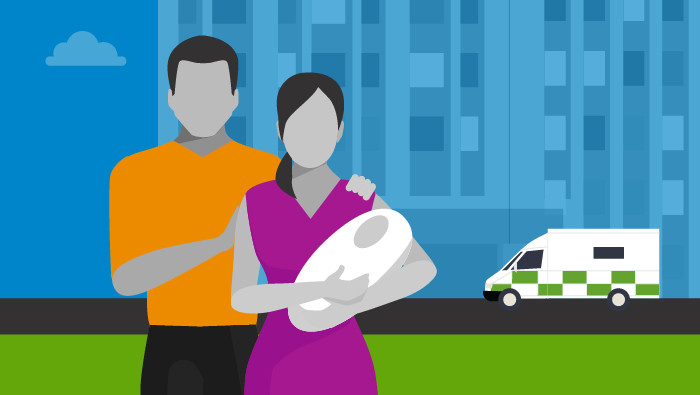Genetic technologies and human health
What if you had the power to prevent a genetic disorder? Or to cure diseases such as leukaemia? Would you do it?

Questions like this once seemed confined to the pages of science fiction. But they have now become a realistic possibility, thanks to rapid developments in genetic technologies over the past 70 years.
Since the discovery of the structure of DNA in the 1950s, geneticists have made new discoveries at a breathtaking rate. In 1982, the first drug (insulin to treat diabetes) was produced using genetic engineering, followed by the first trials of gene therapy in humans in 1990.
At the same time, sequencing a human genome has become simpler than ever. The original Human Genome Project took 13 years and cost $3 billion. Today the same process takes three days and costs less than $1,000.
But before we go any further, let’s see what you already know about genetics.
The declining cost of sequencing per genome since 2001

 170,000
170,000
The number of people worldwide thought to have had their genome sequenced for medical research and diagnosis in 2017
Quiz Question 1
DNA stands for Diluted Nitric Acid and it transmits electric signals around our bodies.

Quiz Question 1
The answer is false!
It stands for deoxyribonucleic acid and it carries genetic information.
Quiz Question 2

A gene is a short section of DNA. It’s how you inherit characteristics from your parents.
Quiz Question 2
The answer is true!
Genes contain the instructions to make specific molecules, usually proteins, that determine characteristics
such as eye and hair colour.
Quiz Question 3
A genome is a collection of four or five genes that work together to make complex characteristics such as intelligence.

Quiz Question 3
The answer is false!
A genome is all of an organism’s DNA, including all of its genes. The human genome contains around 20,000 protein-coding
genes.
Quiz Question 4
Genome sequencing reveals the precise order of the genetic letters that DNA is made from.

Quiz Question 4
The answer is true!
Your genetic code is based on four letters (A, T, C, G). The specific order that these letters are arranged
in carries the instructions that make us distinct from other species as well as from each other.
Quiz Question 5
Genome editing techniques such as CRISPR allow you to replace faulty genes with different or healthy genes.

Quiz Question 5
The answer is true!
Genome editing tools like CRISPR have been likened to a 'find and replace' tool for specific sequences of DNA,
although the reality of dealing with DNA is more complex than word processing.
Quiz Question 6
If you use genome editing on a human, then all of the changes you make are inherited by their children.

Quiz Question 6
The answer is false.
Although there is early-stage research into making changes that would be inherited by subsequent generations,
all current genome editing procedures involving humans do not result in changes that would be inherited.
You scored
0/6
Not bad - you can learn more if you read on.
Share your results on


Rapid scientific developments are not uncommon. Less than 70 years after the Wright brothers completed the first successful powered flight, three NASA astronauts flew to the Moon - 385,000 kilometres away.
However, the speed of recent developments in genetic science has thrown up a range of economic, environmental and ethical issues that society is still attempting to process. The fact that your genome can now be sequenced safely and relatively quickly and cheaply means that the difficulty of carrying out related genetic procedures - for example genetic testing or genome editing - is also reduced. It also opens up the technology to a far wider range of individuals and organisations.
So how do you feel about this? How do you think using these technologies might change society? Here we will explore some of the key genetic technologies and probe some of the dilemmas and debates around their use.
Key dates
2003
The Human Genome Project, begun in 1990, was completed, having sequenced 99% of the 3.2 billion letters (A, C, G, T) that make up human DNA.
In a recent public dialogue commissioned by the Royal Society, 70% of people said they had a general interest in genetic technologies.
Genetic technology is already here in the form of genetic testing. This involves tests that identify which variant of a gene you have inherited.
They have a variety of uses, including diagnosing rare diseases and commercial services that provide you with medical information or family history. But a rapidly developing area is analysing the DNA of large numbers of people to improve our understanding of what effects our genes have on our lives. This could help develop treatments that are designed to work with our individual genetic makeups.



These are some of the ways in which genetic testing is used in the UK:
-
Patients provide a blood sample, which can be analysed for a gene or genes linked to a specific disorder or that person's entire genetic code.
-
This is usually processed in a laboratory, although tests for individual genes that can be done on the spot are emerging.
-
Usually just a few genes are tested, but there are whole-genome approaches that look at every letter in your DNA. These include the 100,000 Genomes Project, which is focussing on cancer and rare diseases.
approve of the idea of using genome sequencing in humans as a way of identifying the risk of life-threatening diseases
Poll:
‘Do you agree that genome editing should be used in humans for cosmetic reasons eg changing a person’s eye or hair colour?’
Poll:
- Agree
- Disagree
- Don’t know
of people agree with you, saying that genome editing should be used in humans for cosmetic purposes.*
of people agree with you, saying that genome editing should not be used in humans for cosmetic purposes.*
of people agree with you, saying that they don't know if genome editing should be used in humans for cosmetic purposes.*
*Royal Society public dialogue, 2018
Hopes
for genetic testing
-
If you know you have a genetic disorder, you might be able to get suitable treatment, or act in a way that will reduce the chance of the disease developing.
-
Effective preventive treatment could reduce costs to health services.
-
Even if there is no treatment, accessing information about your future health can help you make decisions about your future, including whether or not to have children.
Concerns
about genetic testing
-
If your genetic data became available to third parties, such as insurance providers, they might offer you a reduced level of service as a result.
-
The cost of genetic testing could take resources away from other parts of the NHS.
-
Being told that you or a family member is at risk of a genetic disorder can affect relationships and cause anxiety.
‘[Genetic testing could] help to remove inequality, because if you're born with a genetic disease, you can't do anything about it. I think if there's a shift to empower people, [...] that's a benefit.’ (Dialogue participant, London)
‘If we have too many people, we'd have to lower our standards of living. If everybody lives another five years we'd run out of space and food, resources’ (Dialogue participant, London)
Would you want to be tested for key genetic disorders? How should genetic testing be performed and who should have access to the information?
Doctors are not only capable of testing for genetic disorders. Doctors hope to use genome editing to ‘find and replace’ genes, either replacing faulty genes with healthy ones, or changing genes to make them behave differently.
This animation explains more about what’s involved.
For some people, this level of genetic intervention raises concerns. What if there are unforeseen side effects? What if the technology gets into the wrong hands?
Let’s take a look at the story of a British baby called Layla to put some of these questions into a real-life context.

Leukaemia is the most common cancer in children under the age of five. In the UK over 85% of affected children survive for five years or more after their cancer is diagnosed. However in 2015, doctors at Great Ormond Street Hospital, London were treating a baby called Layla Richards, whose leukaemia had not responded to any of the conventional treatments.

Knowing that Layla would die without treatment, they turned to an emerging technique which involves extracting a patient’s own T-cells (an immune cell that targets cancers) and genome editing them to make them more effective at targeting leukaemia. These T-cells are then returned into the patient’s body.

Layla Richards did not have enough of her own T-cells, so doctors used T-cells from a donor. This meant that as well as using genome editing to attack the cancer, doctors also carried out further editing to ensure that the donor T-cells wouldn’t be rejected by Layla’s immune system. So there were two levels of genome editing - an unprecedented and pioneering achievement.

The treatment worked. Two years on, Layla Richards is healthy and her cancer hasn’t returned. Layla’s treatment involved somatic cells – which means that the genetic changes in her DNA won’t be inherited by her children. She will continue to be monitored to check for any complications. If further trials of this procedure are successful, then the treatment could become more widely available in the future.
agree with using genome editing in patients as a way of curing an otherwise incurable life threatening disease.
believe that genome editing should be used to enhance human abilities (eg to increase a person’s strength)
Genome editing is also opening up new treatment opportunities for those affected by other diseases:
There are a wide range of opinions on genome editing. For some people and some applications, it is a step too far: we are ‘playing God’ and crossing an ethical boundary. It also raises concerns about affordability (will it be freely available to all?) and regulation (who will control its use?). For others, the benefits outweigh the risks, particularly for those suffering from otherwise incurable diseases.

‘I think the world that we live in faces significant challenges. There’s challenges around food, around medicines, around treating people. Those challenges I don’t think can be answered with conventional science anymore.’ (Dialogue participant, Norwich)

‘I think it's unacceptable. You're going to have a generation of people who have never had to accommodate or, never had to think about anything, any tragedy or tragic situation, what will that do for society? It may make people less compassionate.’ (Dialogue participant, London)

But it’s not just the genomes of children and adults that can be edited using this technology. It is also possible to edit the genomes of embryos.
Because this editing is done at the embryonic level, it means that the change would be permanent, and may be inherited, a process known as germline editing.

It is currently illegal in the UK and US to implant a genetically altered embryo into a woman’s womb, which means that this technique could not be used unless the law is changed. Scientists have said much better evidence on whether the treatment is safe and effective, as well as inclusive public debate, is required before any change in the law should be considered.
Those in favour of using genome editing to treat genetic diseases in embryos argue that it diminishes suffering, and could reduce costs to the wider health system. Those opposed believe that it will reduce respect for difference and increase pressure on groups with characteristics that are labelled as a ‘disorder’.
Key Dates
1978
Birth of Louise Brown, the first IVF baby. At the time people feared IVF would lead to ‘designer babies’, but it is now widely accepted.
Over
250,000IVF babies have been born in the UK
‘It’s easy for those unaffected by genetic diseases to dismiss scientific progress as a step towards a future
in which we start selecting a criterion of eye or hair colour from a design-your-own-baby catalogue. But
for people like me, affected by an incurable genetic disease that caused me to go blind, scientific advancements
into gene editing and mitochondrial replacement therapy offer nothing but hope. If there is any chance of
potentially saving yourself or your baby from illness, don’t tell me you wouldn’t take the opportunity.’
Alex Lee, a freelance writer with interests in technology, culture and politics, August 2017
‘...even if changes to the germ-line turn out to be safe, the underlying ethical concerns of scope and scale
that genome editing brings will remain. If a technique can be used widely and efficiently, without careful
oversight governing its use, it can readily become a new norm or an expectation. Those unable to access the
desired genetic alterations, be they humans with diseases, humans without enhanced genetic characteristics,
or farmers without genetically modified animals or crops, may all find themselves gravely and unfairly disadvantaged.’
Anthony Wrigley and Ainsley Newson, both academics specialising in ethics, March 2015
Do you believe that genome editing should be used in the clinic to treat embryos likely to develop genetic disease, rather
than just for research? For some, it is unacceptable because there are alternative options for parents who
do not wish to pass an inherited genetic condition down to their children. In this argument, genome editing
should only be used as a last resort.
These alternative options are:

-
Parents can choose to adopt. Or they can use a donated embryo that has no direct genetic connection to themselves.
-
Following IVF, it is possible to screen embryos for an abnormal version of a gene and only implant those that will not develop a genetic disease in the woman's womb.
-
Some genetic diseases can be managed. For example, in the case of cardiomyopathy, patients can be monitored, can avoid overexertion and can take medication to regulate their heart rate.
Key Dates
2017
August 2017
CRISPR is used in a research effort to remove a genetic predisposition to heart disease in human embryos.

September 2017
CRISPR is used for the first time by researchers to understand the role of a gene in the early development
of embryos.
Who should regulate?
The simple fact is that society is still making up its mind about genetic technologies. We all have a role to play in deciding how, where and when they should be used. The laws and regulations around genetic technologies will inevitably change as the technology develops further and we will need to work out as a society what we find ethically acceptable.
When the Royal Society carried out a consultation exercise in 2017, there was widespread agreement about the
need for effective and consistent regulation.
Should there be a global regulatory framework for genetic technologies?


Most trusted
to work on genetic technologies
-
University academics and researchers
-
Charities, trusts and foundations
Least trusted
to work on genetic technologies
-
Businesses
-
Privately-funded academics
Based on the Royal Society's public dialogue, there is already a lot of common ground. Most people would agree that genetic technologies have the potential to cure and control disease. There also appears to be agreement on who should be developing these technologies and by whom they should be regulated.
The next step is more complicated: working out how much and how far that technology should be developed and controlled.
This is not just an abstract question. As we grow older, we are all likely to be placed in situations where genetic technologies will offer us or our loved ones an enhanced quality of life. We may find our opinions sharpening or changing in these circumstances. Until then, the Royal Society is continuing to share news and encourage discussions about genetic technologies. Please keep taking part in the conversation on #genetech or find out more about our work in this area and help us to shape the future.
*Qualitative data from workshop participants discussing who they trusted to work on genetic technologies. Quantitative data from survey participants on first choice preferences for who they trust to inform and advise on genetic technologies as follows: Universities, academics, scientists and researchers – 43%; Business working on or funding research 16%; government bodies/policy makers 14%; Regulatory organisations 12%; Charities and campaigning organisations 9%; None of the above 6%

















